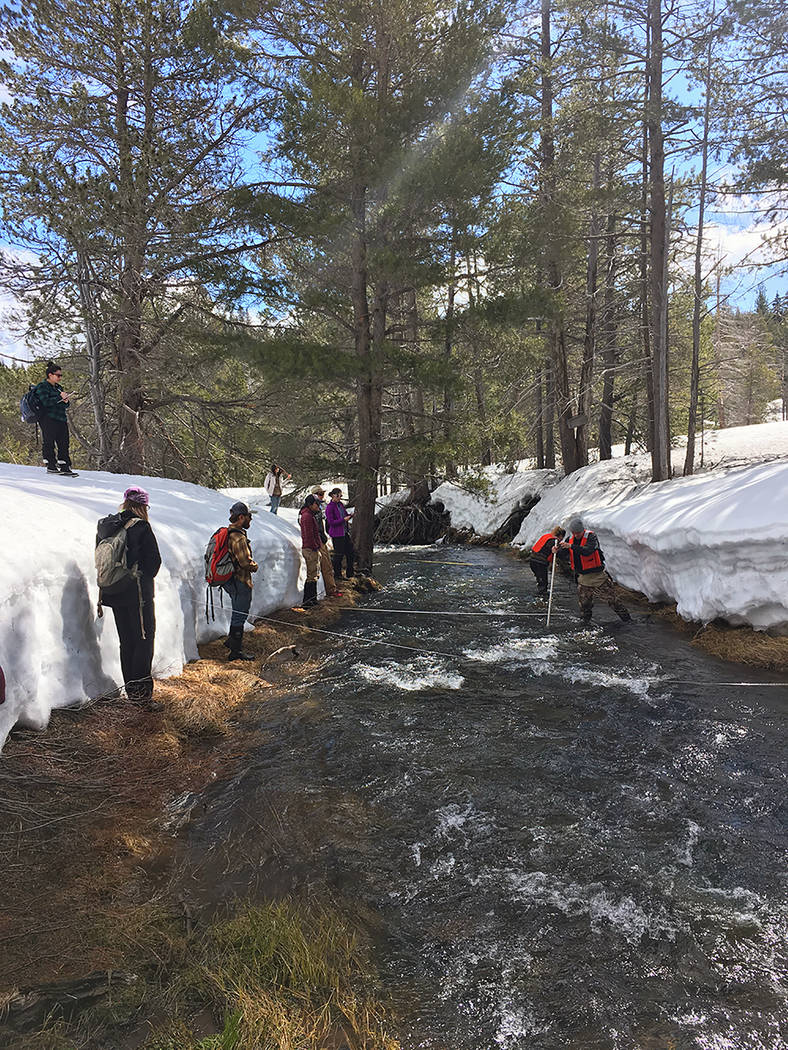Humid air plays key role in water supplies
The future of snowpack and water resources in the American West now has another variable in the equation for water managers – humidity, which can actually increase snowmelt even on a cloudy day.
In a new study published in Proceedings of the National Academy of Sciences, University of Nevada, Reno Assistant Professor Adrian Harpold and his colleague, University of Utah Professor Paul Brooks, show that changes in humidity may determine how the contribution of snowpack to streams, lakes and groundwater changes as the climate warms.
Surprisingly, cloudy, gray and humid winter days actually causes the snowpack to warm, increasing the likelihood of melt during winter months when the snowpack should be growing, according to the study. In contrast, under clear skies and low humidity the snow can become colder than the air, preserving the snowpack until spring.
Harpold, an ecohydrologist, and Brooks, a hydrologist and biogeochemist, looked at snowpack data from more than 400 locations around the West, from the humid Pacific Northwest to the arid desert Southwest.
Across that range of environments, they found that both dry and humid environments responded to climate warming with episodes of snowpack loss during the winter. In humid areas, though, the episodes were primarily winter snowmelt, while in dry areas the episodes were dominated by winter sublimation – direct loss of snow to the atmosphere.
“And these effects are likely to become more intense with more warming,” Harpold said. “We found that relative humidity generally has been both increasing in the Pacific Northwest and decreasing in the desert Southwest over the last 30 years, reinforcing the patterns of winter melt in the Pacific Northwest and sublimation in the Southwest.”
Declining snowpack
Researchers have evaluated different mechanisms that could account for declining snowpack in a warming world: earlier onset of snowmelt, a change in melt rates and shifts from snow to rain under certain conditions. Climate change may also tweak winter humidity up in some regions and down in others.
Brooks said that researchers have known that a changing climate could have major impacts on snowmelt-derived water resources.
“But it has been unclear up to this point,” Brooks said, “why some areas seem to be much more sensitive to change while other locations seem resilient.”
Cloudy, humid days reverse the cooling from both radiation and sublimation – cloud cover prevents snow from emitting energy, and condensation of water vapor on the snow releases latent heat, warming the snow.
That is why a couple of humid days with temperatures right around freezing result in large melt events and even minor flooding. An extreme case of this can come on foggy days, Brooks said. Snow on dry days can “sublimate,” or change directly from a solid to vapor. This process, just like evaporation, absorbs heat and further cools the snow, slowing snowmelt.
“Up to now, future trends in winter humidity have not been a focus of prediction,” Harpold said. “Our work shows this will be a key variable that we will have to predict under climate change.”
Changes in humidity
If humidity increases, water managers may be faced with the challenge of storing water for longer periods while mitigating mid-winter flooding. In contrast, a decrease in humidity will further stress already limited water supplies.
“Long-term planning for reservoirs, water storage and water supply systems is also key for water managers,” Harpold, whose Nevada Mountain Ecohydrology Lab is based in the College of Agriculture, Biotechnology and Natural Resources, said. “For example, in the Sierra and Lake Tahoe you may see a yearly pattern of humid air masses moving over the region, so plans should be made with these regional patterns in mind.
“As we reach a tipping point and see our customary water storage system, the snowpack, melting more and earlier in the winter, systems that rely on snowmelt will need to be re-evaluated and modified. It means that trends and patterns in humidity will be very important to the future of snowpack,” Harpold said.
















